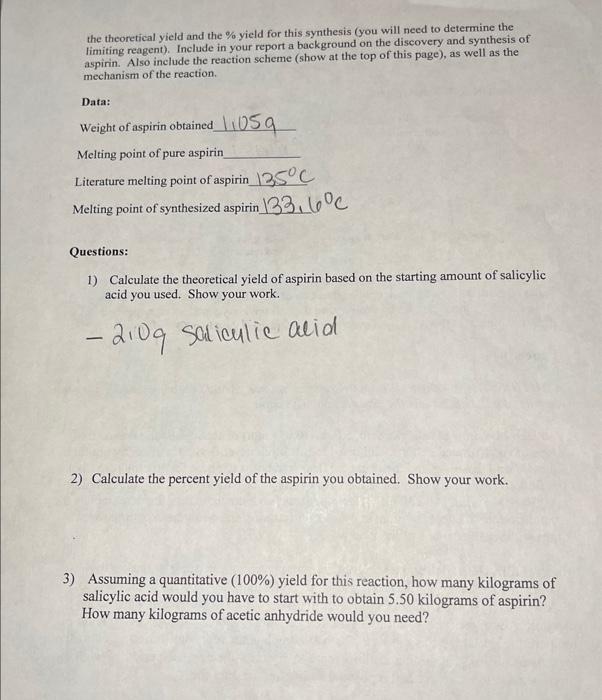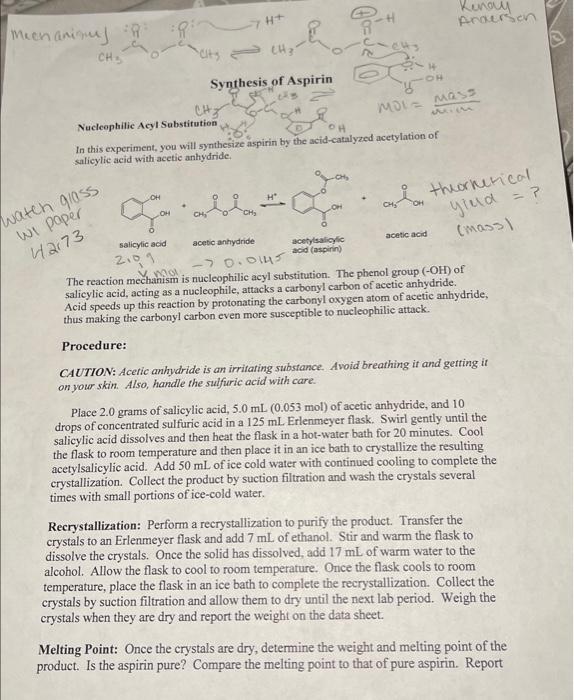questions 1,2,3 all the information is posted.

the theoretical yield and the \% yield for this synthesis (you will need to determine the limiting reagent). Include in your report a background on the discovery and synthesis of aspirin. Also include the reaction scheme (show at the top of this page), as well as the mechanism of the reaction. Data: Weight of aspirin obtained 1,1059 Melting point of pure aspirin Literature melting point of aspirin 125C Melting point of synthesized aspirin 132,10 Questions: 1) Calculate the theoretical yield of aspirin based on the starting amount of salicylic acid you used. Show your work. - 2i0g saliculic alial 2) Calculate the percent yield of the aspirin you obtained. Show your work. 3) Assuming a quantitative ( 100%) yield for this reaction, how many kilograms of salicylic acid would you have to start with to obtain 5.50 kilograms of aspirin? How many kilograms of acetic anhydride would you need? Vucleoplailie Acy I Sabstntion Synthesis of Aspirin In this experiment, you will synthesize aspirin by the acid-catalyzed acetylation of salicylic acid with acetic anhydride. H+8 Anoersen salicylic acid The reaction mechanism is nucleophilic acyl substitution. The phenol group (-OH) of salicylic acid, acting as a nucleophile, attacks a carbonyl carbon of acetic anhydride. Acid speeds up this reaction by protonating the carbonyl oxygen atom of acetic anhydride, thus making the carbonyl carbon even more susceptible to nucleophilic attack. Procedure: CAUTION: Acelic anhydride is an irritating substance. Avoid breathing it and getting it on your skin. Also, handle the sulfuric acid with care. Place 2.0 grams of salicylic acid, 5.0mL(0.053mol) of acetic anhydride, and 10 drops of concentrated sulfuric acid in a 125mL. Erlenmeyer flask. Swirl gently until the salicylic acid dissolves and then heat the flask in a hot-water bath for 20 minutes. Cool the flask to room temperature and then place it in an ice bath to crystallize the resulting acetylsalicylic acid. Add 50mL of ice cold water with continued cooling to complete the crystallization. Collect the product by suction filtration and wash the crystals several times with small portions of ice-cold water. Recrystallization: Perform a recrystallization to purify the product. Transfer the crystals to an Erlenmeyer flask and add 7mL of ethanol. Stir and warm the flask to dissolve the crystals. Once the solid has dissolved, add 17mL of warm water to the alcohol. Allow the flask to cool to room temperature. Once the flask cools to room temperature, place the flask in an ice bath to complete the recrystallization. Collect the crystals by suction filtration and allow them to dry until the next lab period. Weigh the crystals when they are dry and report the weight on the data sheet. Melting Point: Once the crystals are dry, determine the weight and melting point of the product. Is the aspirin pure? Compare the melting point to that of pure aspirin. Report









